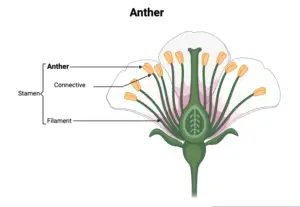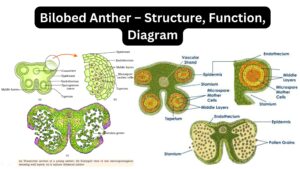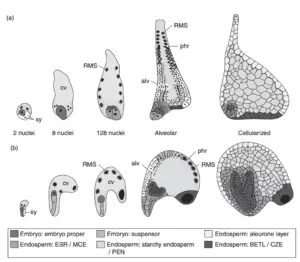What is Seed Dispersal?
- Seed dispersal is a fundamental biological process that enables plants to propagate and establish new individuals in locations away from the parent plant. This mechanism is crucial for minimizing competition among seedlings and optimizing their chances of survival by placing them in environments that may offer better conditions for growth.
- The process of seed dispersal is mediated by a variety of agents, including abiotic factors like wind and water, as well as biotic factors such as animals. Each dispersal agent employs specific strategies adapted to the plant’s environment and life cycle. For example, seeds adapted for wind dispersal often have specialized structures like wings or parachutes that facilitate their aerial transport. On the other hand, seeds dispersed by water are typically buoyant and can travel across aquatic environments before germinating.
- Animals also play a significant role in seed dispersal through various mechanisms. Some plants produce fleshy fruits that attract animals, which consume the fruit and later excrete the seeds in different locations. This method ensures that seeds are deposited in nutrient-rich environments conducive to germination. Additionally, some plants use mechanical means to eject seeds explosively, a method that disperses seeds over a considerable distance from the parent plant.
- The necessity of seed dispersal arises from the limitations that seeds face when falling directly beneath the parent plant. Such seeds often compete with the parent plant for essential resources like light, moisture, and soil nutrients, which can significantly impede their growth and survival. Therefore, by dispersing seeds away from the parent plant, plants increase the likelihood that their offspring will find more favorable conditions for development.
- Seed dispersal strategies can be diverse and sometimes overlap. For instance, the butterfly weed utilizes both mechanical force and wind to distribute its seeds, while the coconut relies on both gravity and water for dispersal. This diversity of mechanisms highlights the adaptability of plants to various environmental challenges and ensures the effective colonization of new habitats.
- Overall, seed dispersal is a critical evolutionary adaptation that enhances the survival and distribution of plant species by employing a range of specialized methods tailored to different environmental conditions and ecological niches.
Types of Seed Dispersal
Seed dispersal is a critical process for plant reproduction, ensuring that seeds are spread to new locations where they can germinate and grow. Various methods have evolved, each adapted to different environmental conditions and ecological interactions. The primary types of seed dispersal include:
- Wind Dispersal:
- Mechanism: Seeds adapted for wind dispersal often have structures such as wings, parachutes, or hair-like appendages that allow them to be carried by air currents. This adaptation enables seeds to travel long distances from the parent plant.
- Examples: Plants like dandelions, cottonwood trees, and orchids utilize wind dispersal effectively. Their light seeds or seed structures facilitate movement through the air, enhancing their chances of colonizing new areas.
- Water Dispersal:
- Mechanism: Seeds adapted for water dispersal are typically buoyant and capable of floating on water. This allows them to be carried away from the parent plant by rivers, lakes, or ocean currents.
- Examples: Coconuts and mangrove seeds are prime examples of water-dispersed seeds. Their coatings or husks are designed to withstand prolonged immersion in water, aiding in their journey to new habitats.
- Animal Dispersal:
- Mechanism: Seeds that rely on animals for dispersal may attach themselves to the fur or feathers of animals, or be ingested and later excreted in different locations. Some plants produce fruit that animals eat, with seeds passing through the digestive system and being deposited elsewhere.
- Examples: Plants like burdock and cherries use animals for seed dispersal. Burdock seeds have hooks that cling to animal fur, while cherries attract animals with their edible fruit, which helps in spreading the seeds.
- Explosive Dispersal:
- Mechanism: Some plants have evolved mechanisms that forcibly eject their seeds from the parent plant. The seeds are released with considerable force, allowing them to scatter over a wide area.
- Examples: Okra and lupins utilize explosive dispersal. Their seed pods burst open when they reach maturity, propelling seeds outward and increasing the range of dispersal.
- Fire Dispersal:
- Mechanism: Certain plants have seeds that are adapted to germinate only after exposure to high temperatures, typically from fires. The heat causes seed pods to burst or soften, facilitating seed release.
- Examples: Lodgepole pine and Eucalyptus are examples of fire-adapted plants. Their seeds are protected within cones or pods that open in response to fire, promoting regeneration in fire-prone environments.
Agents of Seed Dispersal
Seed dispersal is facilitated by various agents, categorized into biotic and abiotic types. Each type of agent plays a crucial role in ensuring that seeds are spread to new locations, thereby enhancing plant reproduction and survival. Below are the primary agents of seed dispersal:
Biotic Agents
Biotic agents are living organisms that contribute to seed dispersal through various interactions:
- Human Beings:
- Mechanism: Humans can inadvertently or intentionally disperse seeds. Seeds may cling to clothing or be transported via vehicles, leading to their spread across different areas. In agriculture, humans sow seeds deliberately to cultivate crops or introduce plant species to new regions.
- Examples: Seeds of various weeds can hitch a ride on clothing or equipment, while agricultural practices often involve planting seeds across large areas.
- Animals:
- Mechanism: Animals contribute to seed dispersal in multiple ways. They may consume fruits and later excrete the seeds in different locations, or seeds can attach to the fur or feathers of animals and be carried to new sites.
- Examples: Birds, such as robins and crows, consume berries and disperse seeds through their droppings. Mammals, like squirrels, may store nuts in different locations, and ants can transport seeds back to their nests.
Abiotic Agents
Abiotic agents are non-living environmental factors that assist in seed dispersal:
- Wind:
- Mechanism: Seeds adapted for wind dispersal often have specialized structures like wings or parachutes, which allow them to be carried away from the parent plant by air currents. This method can spread seeds over long distances.
- Examples: Plants like the dandelion and the helicopter plant possess structures that enable their seeds to travel through the air. Their lightweight and aerodynamic features facilitate dispersal over broad areas.
- Water:
- Mechanism: Some seeds are adapted to float on water, enabling them to be transported across aquatic environments. This adaptation helps in dispersing seeds from the parent plant to new locations.
- Examples: Coconuts and mangrove trees have seeds that are buoyant and can float on water. This allows them to be carried by rivers, lakes, or ocean currents to different shores or estuaries.
Seed Dispersal by Gravity
Seed dispersal by gravity is a straightforward yet effective method by which plants spread their seeds. This process relies on the natural force of gravity to move seeds away from the parent plant, facilitating their germination in new locations. Here is a detailed look at how gravity contributes to seed dispersal:
- Mechanism:
Gravity dispersal occurs when seeds or fruits fall from the parent plant due to their weight. This passive method depends on gravity to pull the seeds downward, which then land on the ground or other surfaces. The seeds may roll away from the parent plant, allowing them to spread over a certain distance. - Examples:
- Acorns (Oak Trees):
- Description: Acorns are the seeds of oak trees. These seeds fall from the tree when they mature, influenced by gravity. The heavy, nut-like structure ensures they drop directly below or slightly away from the parent tree.
- Dispersal Process: Animals, such as squirrels, often collect acorns and bury them in various locations as a food reserve. These buried acorns may eventually germinate if they are not retrieved by the animals.
- Hazelnuts:
- Description: Hazelnuts, also known as cobnuts or filberts, are the seeds of the hazel tree. They are encased in a husk and fall to the ground when mature.
- Dispersal Process: The nuts typically roll away from the parent tree due to their shape and the force of gravity. This rolling helps spread the seeds to new locations where they can potentially germinate.
- Walnuts:
- Description: Walnuts are heavy, hard-shelled fruits that fall from the walnut tree when ripe. Their seeds are encased in a tough outer husk.
- Dispersal Process: The seeds fall to the ground and may roll away from the parent tree. As the outer husk decomposes, the seeds have the opportunity to germinate in new locations.
- Acorns (Oak Trees):
Advantages of Seed Dispersal
Seed dispersal offers numerous advantages to plants and ecosystems, promoting plant diversity, survival, and ecosystem health. The following outlines the key benefits of seed dispersal:
- Nutritional Support:
- Description: Seeds contain stored nutrients that sustain the seedling during its early stages of growth. This stored food is crucial for the seed’s development until it becomes capable of photosynthesis and independent nutrient acquisition.
- Benefit: Ensures that the seedling has adequate resources to begin growth, increasing its chances of survival and establishment.
- Extended Storage:
- Description: Seeds can be preserved for extended periods, serving as a long-term food source. This ability to remain viable over time allows seeds to wait for optimal conditions before germination.
- Benefit: Provides flexibility in timing, allowing seeds to germinate when environmental conditions are favorable, which can lead to better survival rates.
- Formation of New Plant Colonies:
- Description: Dispersal mechanisms enable seeds to spread to new areas, facilitating the establishment of new plant colonies. This can occur through various agents such as wind, water, animals, or mechanical means.
- Benefit: Promotes the expansion of plant populations into new habitats, which can enhance genetic diversity and resilience.
- Reduction of Competition:
- Description: By dispersing seeds away from the parent plant, the seeds avoid competing with the parent for essential resources like water, minerals, and sunlight.
- Benefit: Reduces intraspecific competition, which can lead to higher survival rates and healthier plant populations.
- Adaptation to Human-Influenced Environments:
- Description: In areas affected by human activities, such as urban and agricultural landscapes, seed dispersal by animals helps many plant species survive and thrive.
- Benefit: Assists in the conservation of plant species in modified environments, supporting biodiversity and ecological balance.
- Ecosystem Health and Restoration:
- Description: Effective seed dispersal is crucial for the maintenance and restoration of diverse ecosystems, from deserts to evergreen forests. It contributes to the regeneration of plant communities and the overall health of ecosystems.
- Benefit: Supports biodiversity, aids in ecosystem restoration efforts, and maintains ecological processes essential for environmental stability.
Significance of Seed Dispersal
Seed dispersal is a fundamental process with profound implications for plant survival and ecosystem stability. The following points highlight its significance:
- Enhanced Plant Survival:
- Description: Seed dispersal ensures that seeds are transported away from the parent plant, reducing competition for resources such as light, water, and nutrients. This spatial separation improves the chances of seed germination and seedling survival.
- Significance: By minimizing competition and optimizing growth conditions, seed dispersal increases the likelihood that seeds will establish successfully as new plants.
- Increased Genetic Diversity:
- Description: Dispersing seeds to different locations allows for the mixing of genetic material from various individuals. This process promotes genetic diversity within plant populations.
- Significance: Genetic diversity is crucial for the adaptability and resilience of plant species. It enhances their ability to cope with environmental changes and resist diseases, contributing to long-term survival.
- Adaptation to Changing Environments:
- Description: Seed dispersal enables plants to colonize new areas with more favorable conditions. This is particularly important in the context of climate change, where shifting habitats may offer better chances for survival.
- Significance: By facilitating the movement of plants to suitable environments, seed dispersal helps species adapt to changing climatic conditions and maintain their ecological niches.
- Biodiversity Preservation:
- Description: Seed dispersal supports the movement of plant species across various landscapes, contributing to the maintenance of diverse plant communities. It also facilitates the dispersal of seeds by animals, which can influence plant distribution and ecosystem structure.
- Significance: Preserving biodiversity is essential for ecosystem health and stability. Seed dispersal contributes to a balanced ecosystem by promoting a variety of plant species and interactions within the food web.
Example of Seed Dispersal
Examples of seed dispersal illustrate the diverse strategies plants use to spread their seeds and optimize their chances of survival. Here are some notable examples:
- Dandelion: The dandelion seed is an exemplary case of wind dispersal. Each seed is equipped with a parachute-like structure called a pappus, which catches the wind and enables the seed to travel away from the parent plant. This adaptation allows the seed to cover significant distances before settling in a new location.
- Oak Trees: Oak tree seeds, known as acorns, are primarily dispersed by animals. Squirrels and other foragers collect acorns and store them in various locations as food reserves. Some acorns are forgotten and subsequently germinate, leading to new oak trees growing in areas away from the original tree.
- Coconut: Coconuts are adapted for dispersal by water. Their large, buoyant seeds can float on water and are carried by ocean currents across considerable distances. This ability allows coconuts to colonize new coastal areas, promoting the spread of coconut palms.
- Hazelnut: Hazelnuts primarily rely on gravity for seed dispersal. When the nuts fall from the tree, they may roll away from the parent plant due to their shape and the slope of the ground. This method of dispersal can move seeds to areas nearby but often within the vicinity of the parent tree.
- Hellebore: The hellebore plant uses explosive dispersal to spread its seeds. The seeds are forcefully ejected from capsules that burst open when mature. This mechanism propels the seeds away from the parent plant, helping to spread them across a broader area.
FAQ
What is seed dispersal?
Answer: Seed dispersal is the process by which seeds are spread from the parent plant to new locations. This can occur through various mechanisms such as wind, water, animals, and mechanical forces. The goal of seed dispersal is to reduce competition among seedlings and increase the chances of successful germination and growth.
Why is seed dispersal important for plants?
Answer: Seed dispersal is crucial for several reasons. It helps reduce competition for resources like light, water, and nutrients among seedlings and parent plants. It also promotes genetic diversity by spreading seeds across different areas, which can enhance a plant’s adaptability to changing environmental conditions and improve its chances of survival.
Can human activities affect seed dispersal?
Answer: Yes, human activities can significantly impact seed dispersal. For example, deforestation and land development can disrupt natural dispersal pathways and reduce the availability of habitats for dispersing animals. Conversely, humans can also assist seed dispersal through agricultural practices, landscape restoration efforts, and intentional planting of native species.
How does seed dispersal contribute to ecosystem health?
Answer: Seed dispersal contributes to ecosystem health by promoting plant diversity and distribution. It helps plants colonize new areas, supports the establishment of varied plant communities, and facilitates ecological balance. Effective seed dispersal enhances biodiversity, which in turn supports the stability and resilience of ecosystems.
What are the main types of seed dispersal mechanisms?
Answer: The main types of seed dispersal mechanisms include:Wind Dispersal: Seeds are carried away by the wind, often facilitated by adaptations such as wings or parachute-like structures.
Water Dispersal: Seeds float and travel by water, reaching new locations through rivers, lakes, or ocean currents.
Animal Dispersal: Seeds are transported by animals, either through ingestion and subsequent excretion or by sticking to fur or feathers.
Gravity Dispersal: Seeds fall to the ground under the influence of gravity, often rolling away from the parent plant.
Explosion Dispersal: Seeds are forcibly ejected from the fruit due to internal pressure or mechanical mechanisms.



